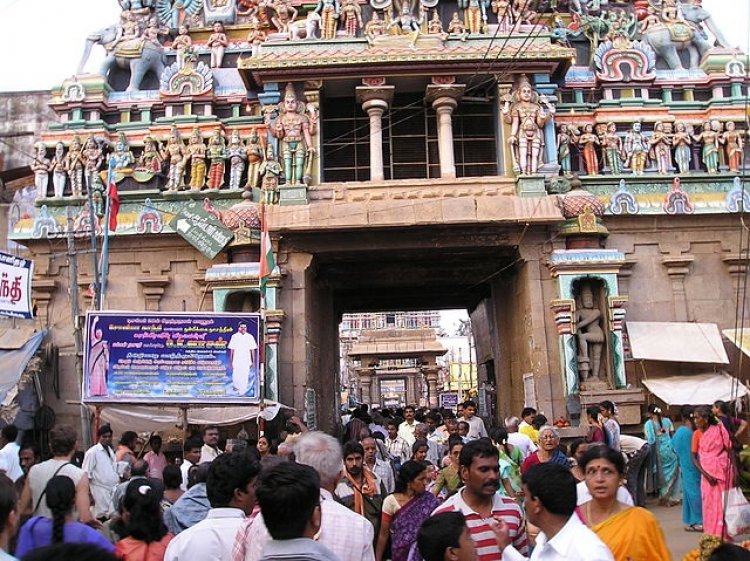A short Note on Ranganathaswamy Temple, Srirangam
Sri Lakshmi Narasimha, Sri Gangadereshwara, Sri Jyothirmaheshwara and other small temples. Among them, the main temple is that of Sri Ranganatha. The inner apartment of Sri Ranganatha temple was built in 817 CE by a lady named Hambi, of the class of dancers in the year 894 CE. It is the most illustrious Vaishnava temple in South India rich in legend and history. The temple has played an important role in Vaishnavism history starting with the 11th-century career of Ramanuja and his predecessors Nathamuni and Yamunacharya in Srirangam. Its location, on an island between the Kollidam and Kaveri rivers, has rendered it vulnerable to flooding as we..

The Sri Ranganathaswamy Temple is a Hindu temple dedicated to Ranganatha, a form of the Supreme God, Maha Vishnu, located in Srirangam, Tiruchirapalli, Tamil Nadu, India.
Constructed in the Dravidian architectural style, the temple is glorified by Alvars in their Divya Prabhanda and has the unique distinction of being the foremost among the 108 Divya Desams dedicated to The Supreme God Vishnu.
Also Read:-
Puranical Story - Ancient Story of Sri Rangam
History- Sri vaishnavism and Puranical Story or ancient Story of Srirangam
A short Note on Ranganathaswamy Temple, Srirangam
Srirangpatna had the name of the Srirangapuri in the early ages. The town is an island being surrounded by the river Cauvery.
In this town, there is the temple of Sri Ranganatha. Sri Lakshmi Narasimha, Sri Gangadereshwara, Sri Jyothirmaheshwara and other small temples. Among them, the main temple is that of Sri Ranganatha. The inner apartment of the Sri Ranganatha temple was built in 817 CE by a lady named Hambi, of the class of dancers in the year 894 CE.
It is the most illustrious Vaishnava temple in South India rich in legend and history. The temple has played an important role in Vaishnavism history starting with the 11th-century career of Ramanuja and his predecessors Nathamuni and Yamunacharya in Srirangam.
Its location, on an island between the Kollidam and Kaveri rivers, has rendered it vulnerable to flooding as well as the rampaging of invading armies that repeatedly commandeered the site for military encampment.
The temple was looted and destroyed by the Delhi Sultanate armies in a broad plunder raid on various cities of the Pandyan kingdom in the early 14th century. The temple was rebuilt in the late 14th century, the site fortified and expanded with many more Gopurams in the 16th and 17th centuries.
It was one of the hubs of the early Bhakti movement with a devotional singing and dance tradition, but this tradition stopped during the 14th century and was revived in a limited way much later. The temple occupies an area of 155 acres (63 ha) with 81 shrines, 21 towers, 39 pavilions, and many water tanks integrated into the complex making it the world's largest functioning Hindu temple.
The temple town is a significant archaeological and epigraphical site, providing a historic window into the early and mid medieval South Indian society and culture.
Numerous inscriptions suggest that this Hindu temple served not only as a spiritual center, but also a major economic and charitable institution that operated education and hospital facilities, ran a free kitchen and financed regional infrastructure projects from the gifts and donations it received.
According to Burton Stein, "(...) the stone and copper inscriptions, the basic historical sources of this period, give more information about temples (...) temples mobilized resources of land and money second only to the state and were therefore capable of financing such projects." (...) "During the Chola period, for example, a series of Srirangam temple inscriptions from the reign of Kulottunga I (1070-1118) describe a gigantic process of redevelopment of a large portion of temple lands."
The Srirangam temple is the largest temple compound in India and one of the largest religious complexes in the world.
Some of these structures have been renovated, expanded and rebuilt over the centuries as a living temple. The latest addition is the outer tower that is approximately 73 metres (240 ft)tall, completed in 1987. Srirangam temple is often listed as one of the largest functioning Hindu temple in the world, the still larger Angkor Wat being the largest existing temple.
The temple is an active Hindu house of worship and follows the Thenkalai tradition of Sri Vaishnavism.
The annual 21-day festival conducted during the Tamil month of Margazhi (December–January) attracts 1 million visitors. The temple complex has been nominated as a UNESCO World Heritage Site, and is in UNESCO's tentative list.
What's Your Reaction?










































































